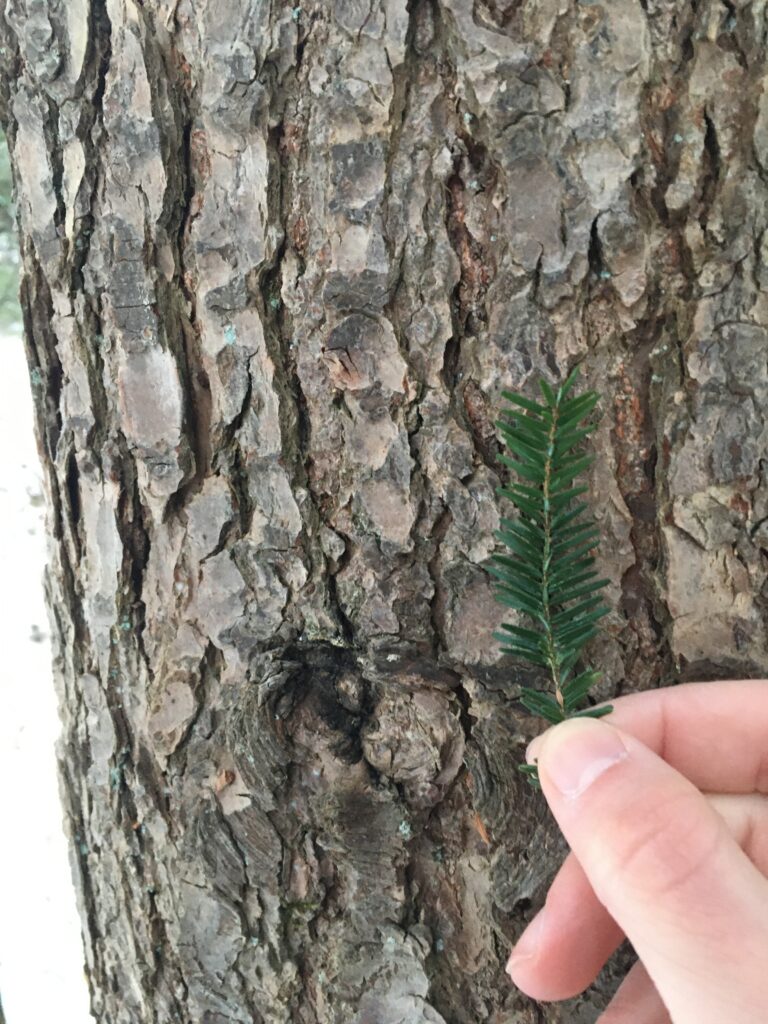During my latest visit to the Projection, I was unable to identify any tracks in the immediate area; it was the second day of warmer weather (around 32°F) and it had been four days since it last snowed. There were a lot of divots and dimples in the snow that may have been warm and melted tracks but to me they look more like snow that had fallen from the trees above. When I arrived at the Projection I heard the “chicka-dee-dee” call of what were most likely black-capped chickadees as well as the cawing of crows. However, soon after my arrival these sounds stopped. I wonder if they fled because of my presence or if the time of day I visited (16:08-16:42) was when the birds began to settle in for the night. Even though it seemed like I was alone, I was accompanied by the many snow fleas (fig. 1, Hypogastrura nivicolor) in the snow around me (Holland, 2010)!

At my site, almost no leaves were left on any of the deciduous trees; the reddish-brown crinkled ones I did see may have been caught between branches if they weren’t truly attached. Moss still clings to many of the coniferous trees in the area and I saw lichens on both deciduous and coniferous trees. I photographed two deciduous twigs from the beings around me. The first (fig. 2) I was able to identify as a barberry; I recalled it was barberry from when it still bore its characteristically tear drop-shaped leaves. Further research allowed me to verify that this plant is a Japanese barberry (Berberis thunbergii) because it bore smooth-margined leaves a few months ago and the twig has three tines (you can see one long one and two shorter ones in figure 2) (“Barberry,” n.d.; “Japanese barberry,” n.d.).

I also photographed the reddish-grey twig of a deciduous tree with reddish buds and opposite branching (fig. 3). With the help of a few online sources I was able to narrow it down to a species of maple; further research led me to the conclusion that the twig belongs to a Norway maple (Acer platanoides) (Fitzgerald, 2010; “boxelder,” n.d.). This made sense because I recall seeing black-spotted maple leaves during earlier visits to the projection.


In the canopy I could see little cones hanging from a conifer nearby; an analysis of the short, flat needles the branches held led me to believe that this tree is an Eastern hemlock (fig. 5, Tsuga canadensis) (“eastern hemlock,” n.d.). However, I wasn’t completely confident in my identification, so I consulted an online dichotomous key and some other sources which helped me confirm my suspicion (“What Tree Is That?,” n.d.).

Also noteworthy were the green ferns still poking out of the snow (fig. 6)! I also saw many of the same bead fronds I had encountered in this area before (fig. 7). In addition, there was a plant close to the fertile frond which I could not identify (fig. 8). I initially supposed it was a bead frond without its beads or a winter wildflower. In the field, if seemed like most of the remaining herbaceous plants were short ones as compared to the tall Joe-Pye weeds I remembered seeing during previous visits. However, this observation relies completely on my memory, for I didn’t take any measurements of the grasses in that area.




References
Barberry. (n.d.). Retrieved from https://vtfishandwildlife.com/learn-more/landowner-resources/liep-invasive-species-program/terrestrial-invasive-plants/barberry
boxelder. (n.d.). Retrieved from https://dendro.cnre.vt.edu/dendrology/lab1.cfm?t1=2
eastern hemlock. (n.d.). Retrieved from http://dendro.cnre.vt.edu/dendrology/syllabus/factsheet.cfm?ID=116
Fitzgerald, H. (2019, October 19). A Guide for Identifying Trees During Stick Season. Kids VT. Retrieved from https://www.kidsvt.com/
Holland, M. (2010). Naturally curious: A photographic field guide and month-by-month journey through the fields, woods, and marshes of New England. North Pomfret, VT: Trafalgar Square Books.
Japanese barberry. (n.d.). Retrieved from http://dendro.cnre.vt.edu/dendrology/syllabus/factsheet.cfm?ID=374
The many faces of a twig. (n.d.). Retrieved from https://phyllotaxy.com/natural-history/trees/twigs-buds/
What Tree Is That? (n.d.). Retrieved from https://www.arborday.org/trees/whattree/
